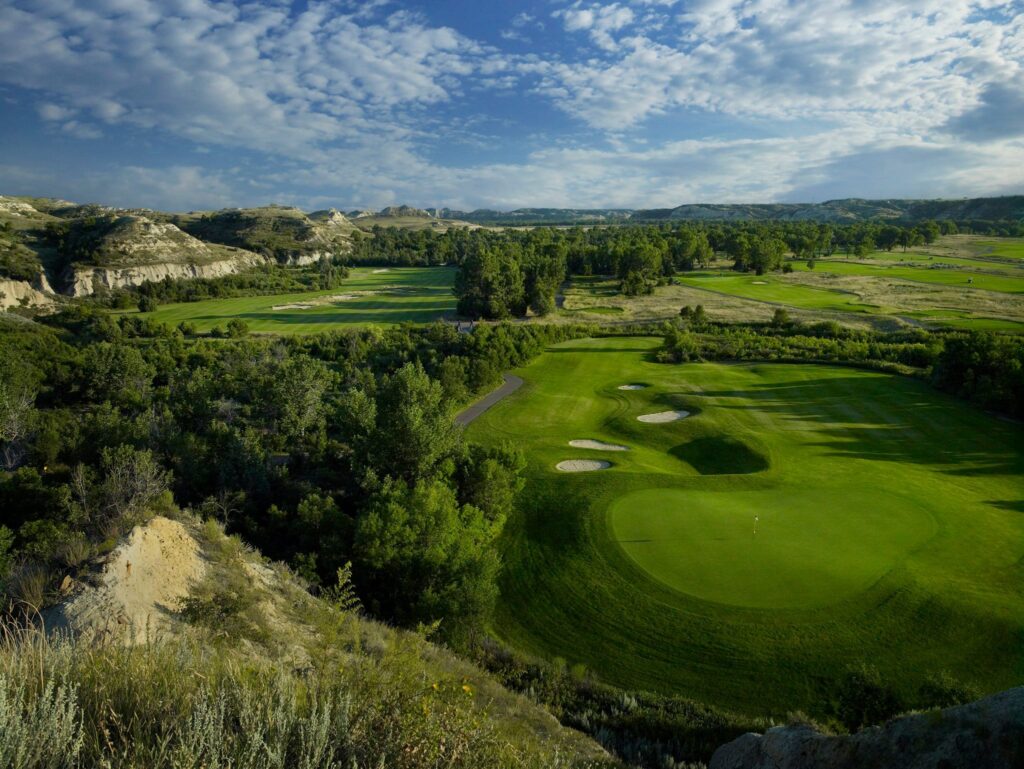
Bully Pulpit
North Dakota is not a destination you just happen upon – it’s a state that you have to work to get to from just about anywhere in the United States.
Bordered on the north by the Canadian provinces of Saskatchewan and Manitoba, to the east by Minnesota and with South Dakota and Montana to the south and west, respectively, North Dakota is a land of broad prairies, steppe, temperate savanna and farmland over most of its vast landscape. It has a smattering of badlands, which are short rocky ridges on which water erosion has cut deep channels, to the west.
North Dakota has less than 800,000 residents, but with a combination of 116 nine- and 18-hole golf courses facilities the Roughrider State has the most courses per capita in America (a course for every 5,500 people). The golf experiences are mostly spread out, as the state has one course for every 561 square miles, which ranks 42nd in the nation.
Where there is great golf, we will find it, and on this feature we will highlight a trio of courses – Hawktree Golf Course in the capital of Bismarck, Bully Pulpit Golf Course an hour west in Medora and The Links of North Dakota an hour north in Williston. All are in the western third of the state and are listed as the top three courses in North Dakota in Golf Digest’s most recent rankings.
Unique bunkers just one of the hallmarks at Hawktree
We started our trip in the state capital of Bismarck, whose airport features flights from Minneapolis, Denver and Dallas.
Hawktree Golf Course, designed by Jim Engh and opened in 2000, is just 15 minutes northeast of the city and routed in a valley between the Missouri River and US 83. It plays at 7,085 yards from its back tees and is a par-72, with rolling hills and water features and often tall native grasses bordering the fairways in an isolated setting.
The course is visually stunning and highly entertaining – and quite difficult – with the elevation changes and the contrasts of colors along separate and unique fairways. One of its distinctive features here is the black sand (or coal slag) in the bunkers – the slag is fine grained like sand but doesn’t provide the spin of usual sand traps.
The putting surfaces are generous and undulating and are well protected by numerous bunkers.
Hawktree rambles through glacier-carved land near the Missouri River, forcing players to contend with high plains winds and water that’s in play on 11 holes. When you arrive at the course, the first thing you notice are the sweeping prairie vistas – 14 holes are visible from the clubhouse.
Environmental sustainability was a top priority for Engh and he took that mantra to the extreme as just 80 acres of turf are irrigated on the course.
The most talked-about hole is the short, par-3 third, on which the tee sits 80 feet above the green. Golfers You can reach the putting surface in two ways: on the cart path or by skillful rope climbing. Most folks choose the cart path, and rightly so.
The most difficult and challenging hole, without a doubt, is the closer, a long par 5 that finishes with a 150-yard uphill approach. If the wind is in your face it’s a real bear to handle.
Hawktree Golf Course’s hearty marketing pitch is that the course offers 18 distinctive, unique holes. It’s a ball to play, especially when you are on your A-game.

Hawktree
Bully Pulpit is great – and a bit of a chameleon
Two hours dead west of Bismarck at edge of the badlands and three miles south of Medora is
Bully Pulpit Golf Course, which has been consistently rated as one of America’s Top 100 Public Golf Courses.
Bully Pulpit Golf Course was forged out of the Little Missouri River valley in the spirit of former President Theodore Roosevelt. Roosevelt often used the word “bully,” and the term “Bully Pulpit” stems from his reference to the White House as a terrific platform from which to advocate an agenda persuasively.
Roosevelt often fed his wilderness craving in the North Dakota badlands, hunting buffalo and ranching cattle among the region’s stark sandstone hills.
Bully Pulpit Golf Course was designed by Dr. Michael Hurdzan and opened for play in 2005. It plays at almost 7.300 yards from the tips and is a par-72 through cottonwood trees and open prairie and into the badlands themselves for an unforgettable three-hole moonscape stretch – the 404-yard 14th, 161-yard 15th and 451-yard 16th.
The course was built using the existing land over a roomy 900-plus acres, with a handful of holes routed along a mile or more of Little Missouri. The badlands, described as “hell with the fires gone out,” is rugged land with frequent sightings of wild bison and horses, bighorn sheep, antelope, mountain cats, coyotes, turkeys, prairie dogs, and snakes, so it’s prudent to keep your ball in the fairway.
Fifteen of the holes on Bully Pulpit are in the river basin, and that leads, quite often, to its chameleon quality. The Little Missouri floods regularly, and when it does can take the holes routed on the river down the line with it.
The course has two different personalities: those the first 13 holes where that’s a little bit of links style with a lot of the tall fescue lining the fairways, and then the “wow” section, when you’re playing some unbelievable canyon golf with 360-degree views and the chance to see all the way to Montana before returning to the valley.
It’s a beautiful combination of fun and unforgettable vistas and a must-play if you are in this part of the Midwest.
Nearby Medora is a restored western town with a history that includes Roosevelt, General George Armstrong Custer and Native Americans. The area is where the Little Missouri River meets the Dakota badlands and the Theodore Roosevelt National Park.

Bully Pulpit
Round at Links of North Dakota reminds one of British and Ireland coastal courses
The Links of North Dakota is located in northwest North Dakota 28 miles from Williston on bluffs overlooking Lake Sakakawea. But on a round here a golfer might actually forget that and think they’ve been somehow transported to the British Isles or Ireland and are teeing it up at fabulous links there.
By definition a links course is one built on sandy soil that drains well and provides hard and fast running fairways and greens with uneven lies throughout. The Links of North Dakota fulfills that definition and does so in spades. There are no trees in play on the course and no water hazards but 85 bunkers, some of them cleverly hidden, grab even the well-played shot. The wind is always a factor, even on the large putting surfaces.
Designed by Stephen Kay, the Links of North Dakota plays to 7,092 yards from the championship tees. The course is located in the heart of the region’s Bakken Oil Formation and is the area’s only 18-hole championship golf course with Bentgrass greens, fairways and tee boxes and a routing that allows a true game along the ground. The fairways are wide open but lined by roughs of punishing tall fescue and prairie grass.
Kay moved a minimal amount of dirt in placing this course on the rolling land overlooking the big lake, and you can expect some uneven lies. The topography he found here is unique to the region.
“It’s like something you would see in Ireland – sandy soil all over the property several feet deep without a rock in it,” Kay said. “The entire state of North Dakota is clay and horrible soil except for this one little 250-acre hill with sandy loam soil.”
The front nine offers dramatic views of Lake Sakakawea, which was formed when parts of the Missouri River was dammed, while the back has beautiful landscapes with the lake in the distance.
No hole here could be considered the signature offering without views of Lake Sakakawea creating the backdrop, and the 457-yard par-4 15th puts it on full display. The infinity edge green with the water in the background delivers an inspiring view.
The Links of North Dakota has frequently been recognized as the top course in North Dakota by Golfweek and Golf Digest.
Making the trip to North Dakota for golf will take a little planning, but the experiences here are more than worth it.

Links of North Dakota

